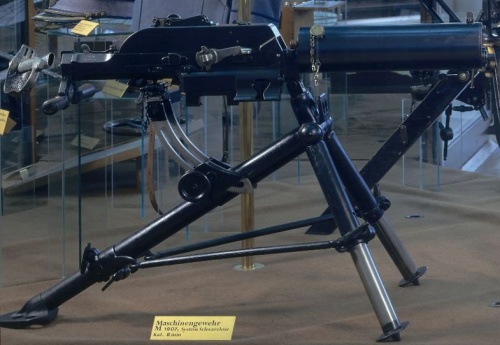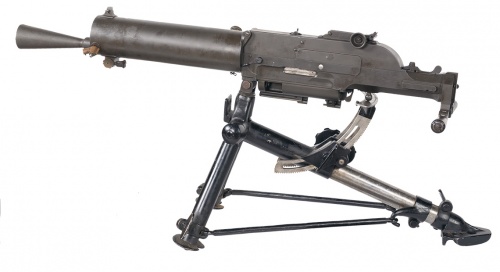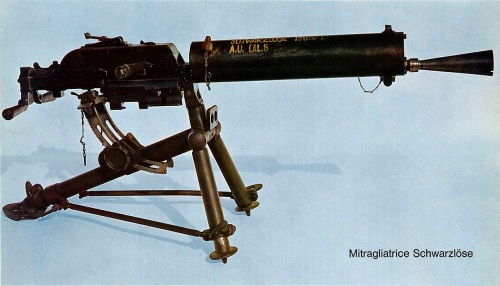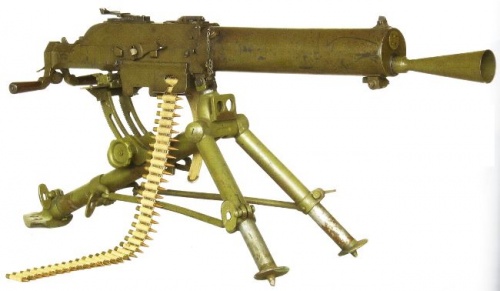| If you have been locked out of your account you can request a password reset here. |
Difference between revisions of "Schwarzlose Machine Gun Model 07/12"
(→Film) |
|||
| Line 1: | Line 1: | ||
| − | [[Image: | + | [[Image:SchwarzloseM07MG.jpg|thumb|right|500px|Schwarzlose MG M.07 - 8x50mmR Mannlicher.]] |
| − | + | The '''Schwarzlose machine gun''' is a water-cooled, belt-fed machine gun designed by Andreas Wilhelm Schwarzlose for the Austro-Hungarian Army in 1907. While after the establishment of the [[Maxim]] construction many countries of the world placed orders with the large manufacturers [[Vickers]] or DWM (''Deutsche Waffen- und Munitionsfabriken'' AG) or applied for their own production, the Austro-Hungarian Empire took other paths. Around 1902, the Berlin engineer Andreas Schwarzlose applied for a patent for his own design of a machine gun. The [[Steyr|Steyr-Werke]] acquired the license in 1905, and in 1907 it was introduced to the Austrian armed forces as the M.07, chambered in 8X50R. This model has a gap between the top cover and the water jacket. Some improvements led from 1912 on to the M.07/12. | |
| − | The '''Schwarzlose machine gun''' is a water-cooled, belt-fed machine gun designed by Andreas Wilhelm Schwarzlose for the Austro-Hungarian Army in 1907. | ||
| − | Schwarzlose, who had | + | Schwarzlose, who had already drawn attention to himself before with technically highly interesting constructions in the field of weapon technology, broke completely new ground. His MG had a fixed barrel and was essentially based on the function of a delayed spring-mass breech. At no time during the firing process was the system positively locked. On the other hand, a relatively strong closing spring, few but solid and therefore robust locking parts and retarding lever forces together with a short barrel provided the reloading cycle. A small shadow is cast on this ingenious design by the need for case lubrication, which was deemed necessary to reduce extraction resistance and thus minimize the risk of case tearing. One oil filling of five liters was enough for about 4,500 cartridges. The Austro-Hungarian Aviation Troops were equipped with the M.07/12/R16, which was an air-cooled version of the M. 7/12. During World War I, Austria-Hungary exported the MG M. 7/12 to Bulgaria and the Ottoman Empire. |
| − | The | + | The way it is constructed initially suggests that the Blackless CMM is too dependent on predetermined functional parameters such as caliber, laboratory and especially barrel length to be easily adapted to other charges of the same caliber or other calibers. Interestingly, however, it has been possible to adapt the MG to such different calibers as the improved cartridge M.31 (Austria, Hungary after 1931), 6.5 mm Mannlicher-Schönauer, 6.5 mm Swedish or even 8X57IS. |
| − | + | Manufacturers were from 1905 to 1918 ''Österreichische Waffenfabriks-Gesellschaft'' (OeWG), Steyr and from 1914 to 1918 [[FÉG|FGGY]] in Budapest. Another manufacturer was in Holland, ''Artillery Inrichtingen'', that strongly oriented to the M.07 and was further developed to M08/13 and M08/15, chambered in 6.5×53mmR. In Sweden, it was manufactured by Carl Gustav as the ''Kulspruta'' M/1914 (which looks exactly the same as the M. 07/12, but has the Swedish national coat of arms on the water cooling jacket) and was used for decades in the Swedish army. It adorns to this day the medal of the Swedish MG gunners. | |
| − | + | It was used in both world wars and also afterward on many fronts, from Scandinavia to North Africa. | |
__TOC__<br clear="all"> | __TOC__<br clear="all"> | ||
== Specifications == | == Specifications == | ||
| + | [[Image:Schwarz 07-12.jpeg|thumb|right|500px|Schwarzlose MG M.07/12 - 8x50mmR Mannlicher.]] | ||
'' Schwarzlose Machine Gun Model 07/12'' | '' Schwarzlose Machine Gun Model 07/12'' | ||
| Line 32: | Line 32: | ||
* '''Weight:''' (unloaded) 44lbs (19.9kg) | * '''Weight:''' (unloaded) 44lbs (19.9kg) | ||
| + | The '''Maschinengewehr 07/12''' was the standard machine gun of the K.u.k Army. It was introduced in 1912 as an improved version of the M.07. The M. 07/12 had an increased rate of fire of 500 rounds per minute compared to the predecessor M. 07, automatic steam discharge of the water cooler, an enlarged oiler and other design changes. The externally distinguishing feature of the two models: | ||
| + | on the M.07, the barrel jacket does not extend to the housing. | ||
| + | |||
| + | The Austro-Hungarian Air Force, ''k.u.k. Luftfahrtruppen'', was equipped with the M.07/12/R16, which was an air-cooled version of the M. 7/12. During World War I, Austria-Hungary exported the MG M. 7/12 to Bulgaria and the Ottoman Empire. | ||
| + | |||
| + | During World War I, Austria-Hungary exported the MG M. 7/12 to Bulgaria and the Ottoman Empire. The Schwarzlose was also exported and reused in the successor states of the K.u.K. monarchy. For this purpose, it was converted to other ammunition. This model had only ten functional parts, therefore, it was very reliable and was also used as a prey weapon by the enemy. The M. 07/12 was still in use during the Second World War. | ||
| + | |||
{{Gun Title}} | {{Gun Title}} | ||
| Line 46: | Line 53: | ||
|- | |- | ||
| ''[[If War Comes Tomorrow (Esli zavtra voyna)]]'' || || || Seen in documentary footage || 1938 | | ''[[If War Comes Tomorrow (Esli zavtra voyna)]]'' || || || Seen in documentary footage || 1938 | ||
| − | |||
| − | |||
|- | |- | ||
| ''[[The Four Days of Naples (Le quattro giornate di Napoli)|The Four Days of Naples]]'' || || Italian Resistance fighters || || 1962 | | ''[[The Four Days of Naples (Le quattro giornate di Napoli)|The Four Days of Naples]]'' || || Italian Resistance fighters || || 1962 | ||
| Line 92: | Line 97: | ||
| ''[[Battlefield: 1918]]'' || || || 2004 | | ''[[Battlefield: 1918]]'' || || || 2004 | ||
|- | |- | ||
| − | | ''[[Battle of Empires : 1914-1918]]'' || || || 2014 | + | | ''[[Battle of Empires: 1914-1918]]'' || || mounted on a car || 2014 |
|- | |- | ||
| ''[[Tannenberg]]'' || "Schwarzlose M.07/12 " || with shield || 2019 | | ''[[Tannenberg]]'' || "Schwarzlose M.07/12 " || with shield || 2019 | ||
| + | |- | ||
| + | |} | ||
| + | |||
| + | <br clear="all"> | ||
| + | |||
| + | ==Schwarzlose M.08== | ||
| + | |||
| + | [[Image:07-12.jpg|thumb|right|500px|Dutch Schwarzlose MG M. 08/13 - 6.5×53mmR]] | ||
| + | |||
| + | ===Film=== | ||
| + | {| class="wikitable" style="font-size: 95%;" border="1" style="border: 1px solid #D0E7FF; background-color:#ffffff; text-align:left; font-size: 95%" | ||
| + | |-bgcolor=#D0E7FF | ||
| + | !align=center bgcolor=#D0E7FF width="280"|'''Title''' | ||
| + | !align=center bgcolor=#D0E7FF width="170"|'''Actor''' | ||
| + | !align=center bgcolor=#D0E7FF width="180"|'''Character''' | ||
| + | !align=center bgcolor=#D0E7FF width="250"|'''Note''' | ||
| + | !align=center bgcolor=#D0E7FF width="50"|'''Date''' | ||
| + | |- | ||
| + | |- | ||
| + | |''[[Operation Amsterdam]]'' || || || M. 08/15 (anti-aircraft version) || 1959 | ||
|- | |- | ||
|} | |} | ||
| Line 101: | Line 126: | ||
==Schwarzlose M1907/24== | ==Schwarzlose M1907/24== | ||
| − | [[Image:Schwarzlose_07-24.jpg|thumb|right|500px|Czechoslovak | + | [[Image:Schwarzlose_07-24.jpg|thumb|right|500px|Czechoslovak Schwarzlose-Janeček vz.07/24 - 7.92x57 Mauser. Note it has a longer barrel jacket, compared to other models.]] |
| − | Czechoslovakia | + | In 1918, Czechoslovakia, as a successor state of Austria-Hungary, added a larger number of Schwarzloses to its armed forces. From 1924 on, these weapons were converted to the 7.92 × 57 mm caliber and designated as M07/24. After the German occupation of Czechoslovakia, the ''Wehrmacht'' took over the weapons captured there in 1939, especially since they had the same caliber as the German rifles and machine guns, and used it primarily as a heavy machine gun in the machine gun companies of the infantry divisions of the 5th and 6th ''Aufstellungswelle'', which were mainly equipped with Czech weapons. Later replaced by other more modern weapons, reserve stocks were still used in the ''Volkssturm'' toward the end of the war. |
===Film=== | ===Film=== | ||
| Line 136: | Line 161: | ||
| rowspan=2 | ''[[Capitaine Conan]]'' || [[Philippe Torreton]] || Captain Conan || rowspan=2 | standing for M. 7/12 || rowspan=2 | 1996 | | rowspan=2 | ''[[Capitaine Conan]]'' || [[Philippe Torreton]] || Captain Conan || rowspan=2 | standing for M. 7/12 || rowspan=2 | 1996 | ||
|- | |- | ||
| − | | || Bulgarian and French soldiers , Bolsheviks | + | | || Bulgarian and French soldiers, Bolsheviks |
|- | |- | ||
| ''[[Company of Heroes (2013)|Company of Heroes]]'' || || German soldiers || || 2013 | | ''[[Company of Heroes (2013)|Company of Heroes]]'' || || German soldiers || || 2013 | ||
Revision as of 09:10, 27 November 2020
The Schwarzlose machine gun is a water-cooled, belt-fed machine gun designed by Andreas Wilhelm Schwarzlose for the Austro-Hungarian Army in 1907. While after the establishment of the Maxim construction many countries of the world placed orders with the large manufacturers Vickers or DWM (Deutsche Waffen- und Munitionsfabriken AG) or applied for their own production, the Austro-Hungarian Empire took other paths. Around 1902, the Berlin engineer Andreas Schwarzlose applied for a patent for his own design of a machine gun. The Steyr-Werke acquired the license in 1905, and in 1907 it was introduced to the Austrian armed forces as the M.07, chambered in 8X50R. This model has a gap between the top cover and the water jacket. Some improvements led from 1912 on to the M.07/12.
Schwarzlose, who had already drawn attention to himself before with technically highly interesting constructions in the field of weapon technology, broke completely new ground. His MG had a fixed barrel and was essentially based on the function of a delayed spring-mass breech. At no time during the firing process was the system positively locked. On the other hand, a relatively strong closing spring, few but solid and therefore robust locking parts and retarding lever forces together with a short barrel provided the reloading cycle. A small shadow is cast on this ingenious design by the need for case lubrication, which was deemed necessary to reduce extraction resistance and thus minimize the risk of case tearing. One oil filling of five liters was enough for about 4,500 cartridges. The Austro-Hungarian Aviation Troops were equipped with the M.07/12/R16, which was an air-cooled version of the M. 7/12. During World War I, Austria-Hungary exported the MG M. 7/12 to Bulgaria and the Ottoman Empire.
The way it is constructed initially suggests that the Blackless CMM is too dependent on predetermined functional parameters such as caliber, laboratory and especially barrel length to be easily adapted to other charges of the same caliber or other calibers. Interestingly, however, it has been possible to adapt the MG to such different calibers as the improved cartridge M.31 (Austria, Hungary after 1931), 6.5 mm Mannlicher-Schönauer, 6.5 mm Swedish or even 8X57IS.
Manufacturers were from 1905 to 1918 Österreichische Waffenfabriks-Gesellschaft (OeWG), Steyr and from 1914 to 1918 FGGY in Budapest. Another manufacturer was in Holland, Artillery Inrichtingen, that strongly oriented to the M.07 and was further developed to M08/13 and M08/15, chambered in 6.5×53mmR. In Sweden, it was manufactured by Carl Gustav as the Kulspruta M/1914 (which looks exactly the same as the M. 07/12, but has the Swedish national coat of arms on the water cooling jacket) and was used for decades in the Swedish army. It adorns to this day the medal of the Swedish MG gunners.
It was used in both world wars and also afterward on many fronts, from Scandinavia to North Africa.
Specifications
Schwarzlose Machine Gun Model 07/12
- County of Origin: Austria
- Type: Machine Gun
- Calibers: 8mm Mannlicher, 7.92mm Mauser, 6.5mm Mauser
- Capacity: 250 round fabric belt
- Cyclic Rate: 400 rds/min
- Length: 42.00in(1066mm)
- Barrel Length: 20.75in(526mm)
- Weight: (unloaded) 44lbs (19.9kg)
The Maschinengewehr 07/12 was the standard machine gun of the K.u.k Army. It was introduced in 1912 as an improved version of the M.07. The M. 07/12 had an increased rate of fire of 500 rounds per minute compared to the predecessor M. 07, automatic steam discharge of the water cooler, an enlarged oiler and other design changes. The externally distinguishing feature of the two models: on the M.07, the barrel jacket does not extend to the housing.
The Austro-Hungarian Air Force, k.u.k. Luftfahrtruppen, was equipped with the M.07/12/R16, which was an air-cooled version of the M. 7/12. During World War I, Austria-Hungary exported the MG M. 7/12 to Bulgaria and the Ottoman Empire.
During World War I, Austria-Hungary exported the MG M. 7/12 to Bulgaria and the Ottoman Empire. The Schwarzlose was also exported and reused in the successor states of the K.u.K. monarchy. For this purpose, it was converted to other ammunition. This model had only ten functional parts, therefore, it was very reliable and was also used as a prey weapon by the enemy. The M. 07/12 was still in use during the Second World War.
The Schwarzlose Machine Gun Model 07/12 and variants can be seen in the following films, television series, video games, and anime used by the following actors:
Film
| Title | Actor | Character | Note | Date |
|---|---|---|---|---|
| Mountains on Fire | Austrian soldiers | M. 7/12 | 1931 | |
| If War Comes Tomorrow (Esli zavtra voyna) | Seen in documentary footage | 1938 | ||
| The Four Days of Naples | Italian Resistance fighters | 1962 | ||
| The Shortest Day (Il giorno più corto) | Italian solders | M. 7/12 | 1963 | |
| The Desert of the Tartars (Il deserto dei Tartari) | Austro-Hungarian soldiers | 1976 | ||
| From Hell to Victory | British soldiers | Standing for Vickers | 1979 | |
| The Roses of the Desert | Italian soldiers | mock-up | 2006 |
Television
| Title | Actor | Character | Note | Date |
|---|---|---|---|---|
| Front Without Mercy (Front ohne Gnade) | Seen among Italian troops; Ep.5 | 1984 | ||
| And Quiet Flows the Don (Tikhiy Don) | Austro-Hungarian soldiers | 2015 | ||
| Babylon Berlin - Season 1 | Police officers | Ep. 03 | 2017 | |
| Ep. 07 | ||||
| Babylon Berlin - Season 2 | Ep. 16 | 2015 |
Video Game
| Game Title | Appears as | Note | Release Date |
|---|---|---|---|
| Battlefield: 1918 | 2004 | ||
| Battle of Empires: 1914-1918 | mounted on a car | 2014 | |
| Tannenberg | "Schwarzlose M.07/12 " | with shield | 2019 |
Schwarzlose M.08
Film
| Title | Actor | Character | Note | Date |
|---|---|---|---|---|
| Operation Amsterdam | M. 08/15 (anti-aircraft version) | 1959 |
Schwarzlose M1907/24
In 1918, Czechoslovakia, as a successor state of Austria-Hungary, added a larger number of Schwarzloses to its armed forces. From 1924 on, these weapons were converted to the 7.92 × 57 mm caliber and designated as M07/24. After the German occupation of Czechoslovakia, the Wehrmacht took over the weapons captured there in 1939, especially since they had the same caliber as the German rifles and machine guns, and used it primarily as a heavy machine gun in the machine gun companies of the infantry divisions of the 5th and 6th Aufstellungswelle, which were mainly equipped with Czech weapons. Later replaced by other more modern weapons, reserve stocks were still used in the Volkssturm toward the end of the war.
Film
| Title | Actor | Character | Notation | Date |
|---|---|---|---|---|
| The Stolen Border (Uloupená hranice) | Czechoslovak troops | 1947 | ||
| Wolves' Lairs (Vlcie diery) | Slovak insurgents | 1948 | ||
| Captain Dabac | Slovak soldiers | 1959 | ||
| Forty-Four Mutineers | Dusan Blaskovic | Tono Mikles | standing for M. 7/12 | 1964 |
| Austro-Hungarian soldiers | ||||
| A Star Called Wormwood (Hvezda zvaná Pelynek) | Rudolf Deyl | Pvt. František Noha | standing for M. 7/12 | 1959 |
| Bosnian guards | ||||
| Von Ryan's Express | German guards | 1965 | ||
| The Day That Shook the World | Austro-Hungarian soldiers | standing for M. 7/12 | 1975 | |
| The World Knows Nothing (Svet nic neví) | Czechoslovak troops | 1987 | ||
| Capitaine Conan | Philippe Torreton | Captain Conan | standing for M. 7/12 | 1996 |
| Bulgarian and French soldiers, Bolsheviks | ||||
| Company of Heroes | German soldiers | 2013 |



